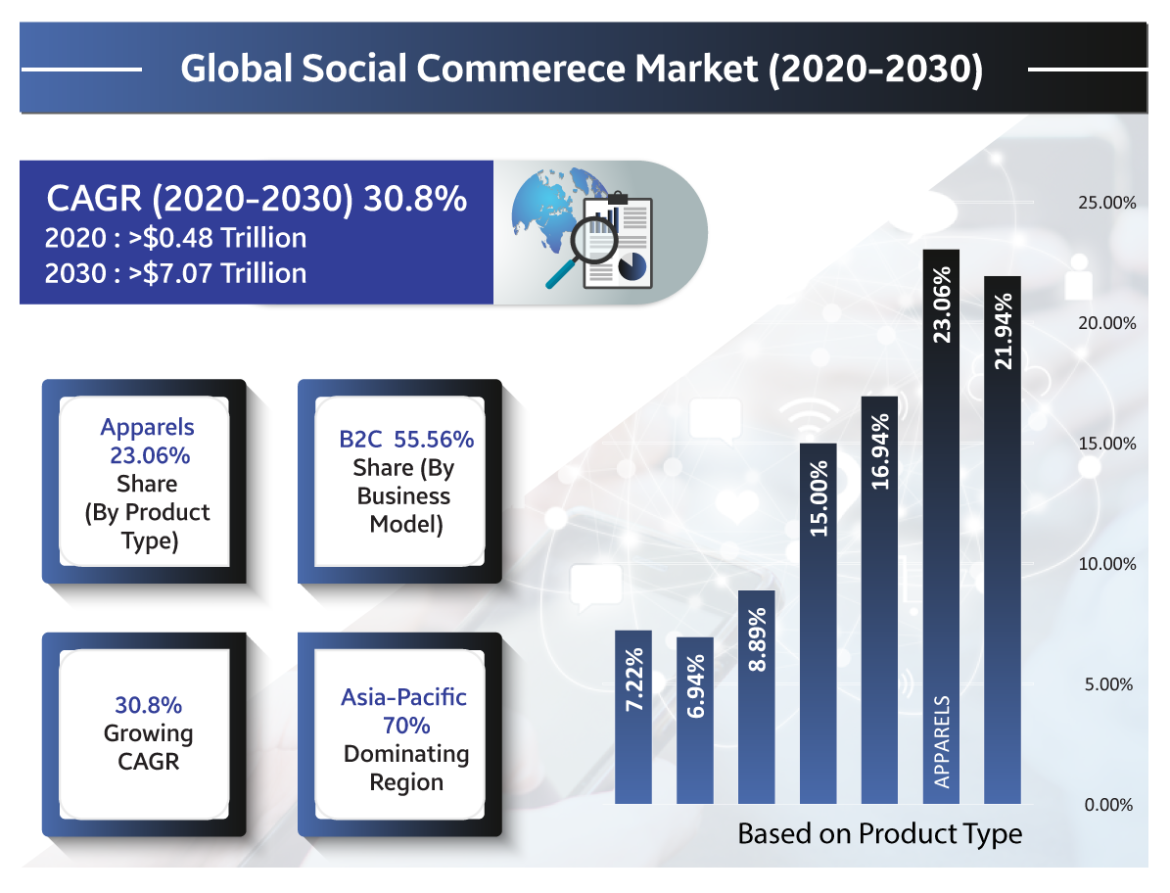The social commerce market promotes and sells products and services with the help of social media platforms such as Instagram, Facebook, and Twitter. The social commerce market size in 2021 was $0.62 trillion, and by 2030 it will reach up to $7.03 as predicted, with a CAGR of 30.8% throughout 2021-2030.
Shoppers can use social commerce to discover brands, research products, and buy items without leaving the app. Social commerce provides a more convenient and interactive shopping experience, which increases its popularity.
Growth factors
Consumer preferences and attitudes have shifted drastically in recent years. One of the major aspects fueling the expansion of the social commerce business is a shift in consumer preferences. Consumers have grown accustomed to instant communication as mobile technology has advanced, and they now expect instant customer service. Furthermore, consumers are seeking new ways to interact with brands utilizing cutting-edge technology, with younger generations leading the social commerce drive. According to the Global Web Index research, social commerce usage is relatively high among Millennials and Generation Z, with over 60% more likely to purchase on a social media platform when given the opportunity.
Furthermore, pandemic-induced lockdowns and restrictions in 2020 influenced in-store customers, including non-digital groups. As social separation became the norm, users began gravitating toward internet buying. Customers became more at ease and confident in investing time and money in a digital environment, clearing the path for market expansion.
Business Model Insights
The industry is divided into three segments based on the business model: business to business (B2B), business to consumer (B2C), and consumer to consumer (C2C) (C2C). The B2C category is predicted to increase substantially during the projection period, with a market share of 54.4% in 2021. Consumer attitude shifts and rising digitization all contribute to the growing need for the business-to-consumer (B2C) business model. Customers can easily examine, select, and order a product while assessing it by reading reviews made by other users on social commerce sites.
Furthermore, during the projected period, the C2C segment is expected to develop at a CAGR of 24.0%. The C2C business model refers to websites that serve as a middleman between clients. This paradigm allows sellers to act as buyers and buyers to act as vendors. Customers can switch between jobs according to their needs. The B2B market is likely to develop steadily in the next years.
Platform /Sales Channel Insights
The market is divided into four categories: video commerce (live stream + pre-recorded), social network-led commerce, social reselling, group buying, and product review platforms. In 2021, Video Commerce dominated the market with a 41.8% share. The segment is predicted to grow rapidly in the next years, rising at a CAGR of 32.9%. In recent years, live stream shopping has expanded dramatically, enticing spectators to purchase from a live shopping event.
Product Type Insights
The apparel sector led the market in 2021, accounting for 23.0% of total revenue. Because of its popularity and demand on social media platforms, the clothes and apparel industry is the most important online business. During the COVID-19 epidemic, as individuals spent more time online and on social commerce sites, fashion merchants discovered new ways to generate new types of shopping experiences, engage influencers/creators, and connect in new ways.
During the projected period, the personal and beauty care segment is expected to develop at the fastest CAGR of more than 30.0%.
Regional Insights
The Asia Pacific had 69.5% of the market in 2021 and is predicted to increase gradually throughout the forecast period. This region’s rise is mostly attributed to reasons such as increased investments in communications infrastructure, the expansion of the internet and smartphones, and the widespread reach of social media websites such as Facebook, Instagram, and Twitter. Furthermore, the growing number of smartphone and social media users in nations such as China primarily benefits regional market growth.
North America emerged as the second-largest market, with a considerable CAGR of over 25.0% predicted throughout the forecast period. In comparison to developing nations, the e-commerce and social commerce landscapes in the United States are much more fragmented, with differences in customer attitudes and behavior regarding social media usage, digital purchasing, payments, and online privacy. According to GWI, 51% of consumers in the United Kingdom and the United States will use YouTube to identify products and conduct extra research before purchasing in 2020.
Key companies and market insight
To remain sustainable in a competitive market, companies employ organic and inorganic growth methods such as product/solution introduction and development, mergers and acquisitions, geographical expansion, and partnerships. Pinterest, for example, partnered with Shopify, Inc., an e-commerce solution provider, in April 2021 to expand its social commerce presence internationally. The collaboration allows the former to offer a Pinterest platform in 27 countries, including the United Kingdom, Austria, Italy, Australia, France, Brazil, Germany, Spain, and Switzerland.
Prominent plays operating in the global social commerce market include Etsy, Inc., Roposo, Pinterest, Twitter, Inc., Meta Platforms, Inc., Fashner technologies private limited, and others.

